Abstract
Polychlorinated biphenyls (PCBs) are among the most widespread environmental pollutants and a prominent contaminant of the Great Lakes basin. Due to their resistance to biodegradation and lipophilic properties, PCBs bioaccumulate in fish tissues and in fish-eating humans. PCBs are also known to cross the placenta and to be excreted into the mother's milk, thus predisposing the infant to potentially adverse health effects. For example, a higher incidence of bacterial infections was reported for breast-fed infants born to mothers who consumed large amounts of Great Lakes fish compared to the incidence in control infants whose mothers ingested low amounts of fish. While data regarding the PCB-induced immunotoxic effects in humans are scarce, data derived from the use of experimental animals, including nonhuman primates, indicate that the immune system is a potential target for the immunotoxic effects of PCBs. Such studies have used the commercially available PCB mixtures alone. However, PCBs have the potential of partially antagonizing the effects of other structurally related compounds including the highly toxic dioxins, which are also present in small amounts in the Great Lakes. Thus, to fully evaluate the magnitude of the immunotoxic risk PCBs pose to humans, consideration should be given to investigations in which the interactive effects of PCBs are combined with other contaminants present in the Great Lakes.
Full text
PDF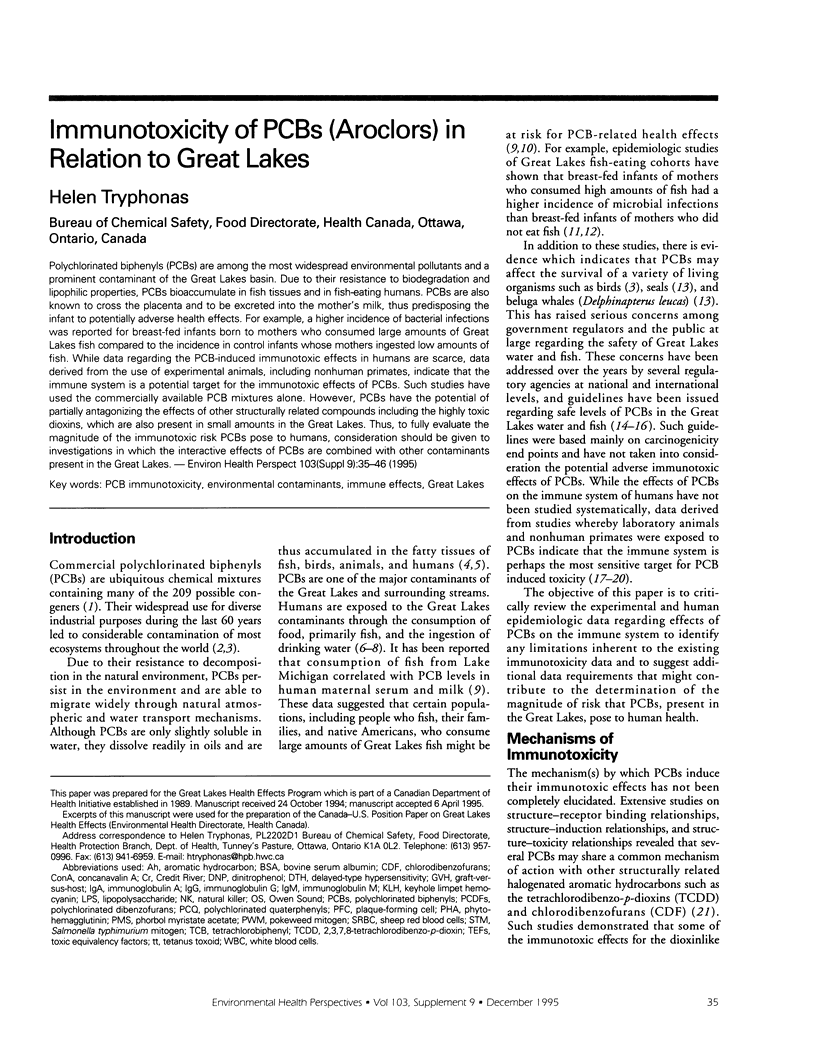
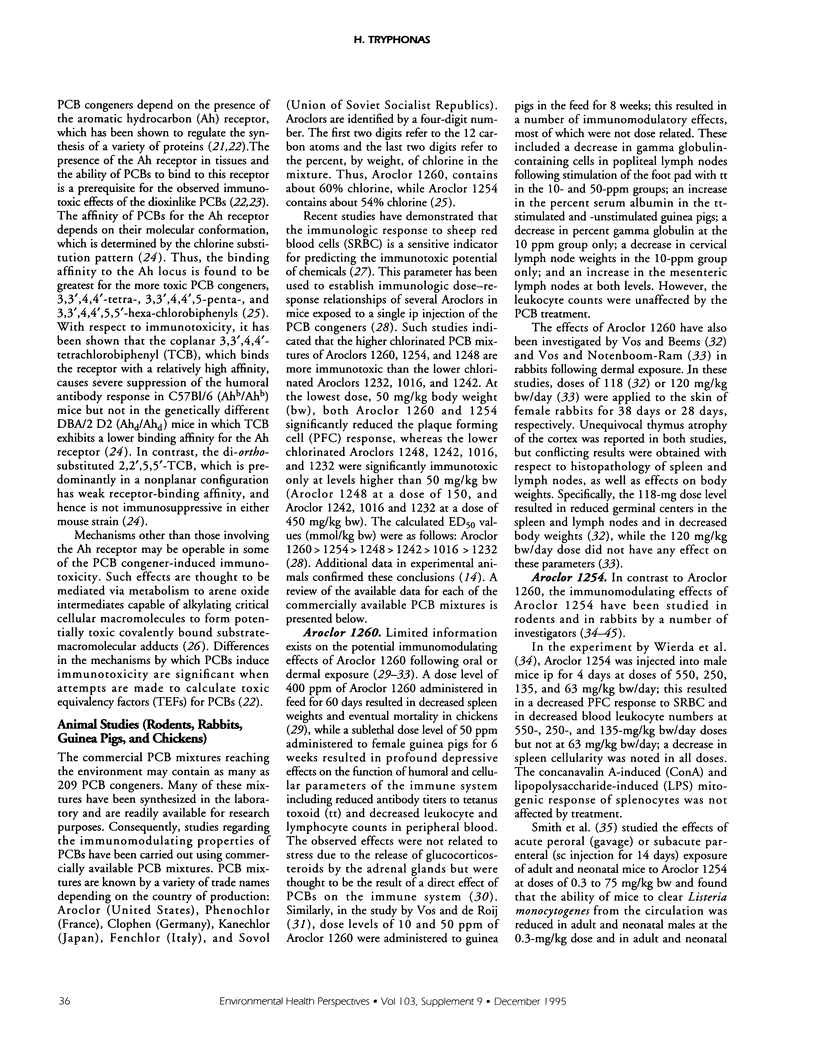
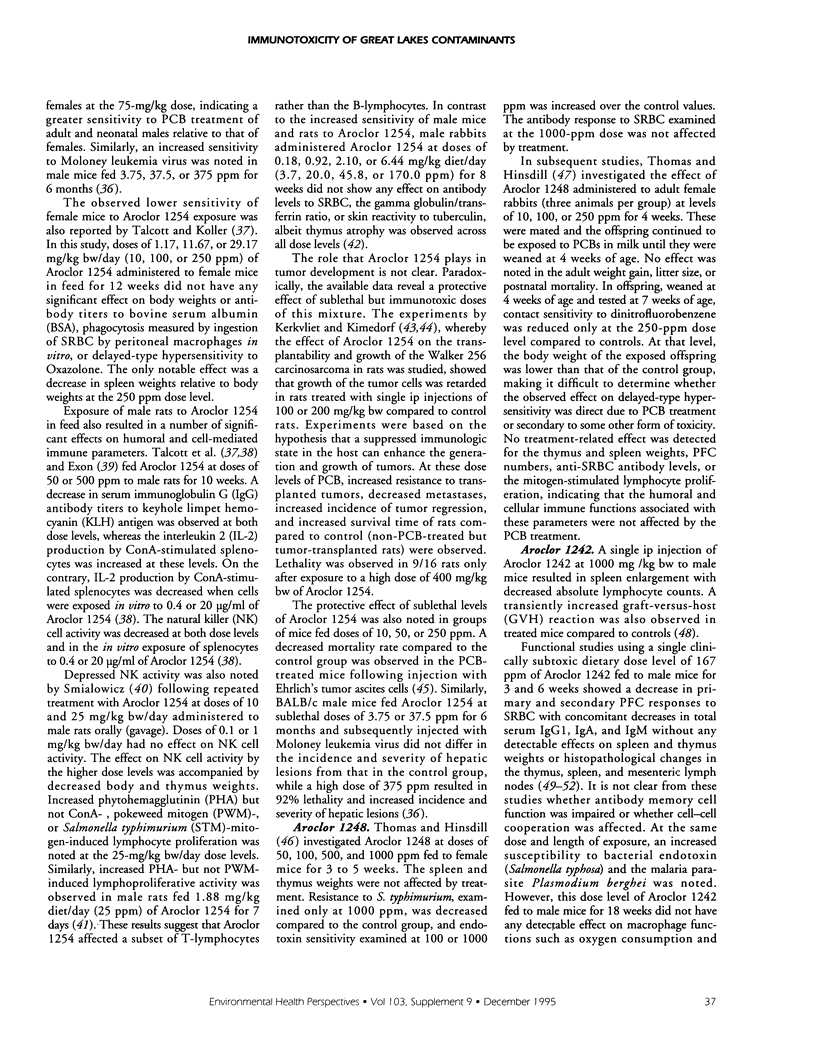
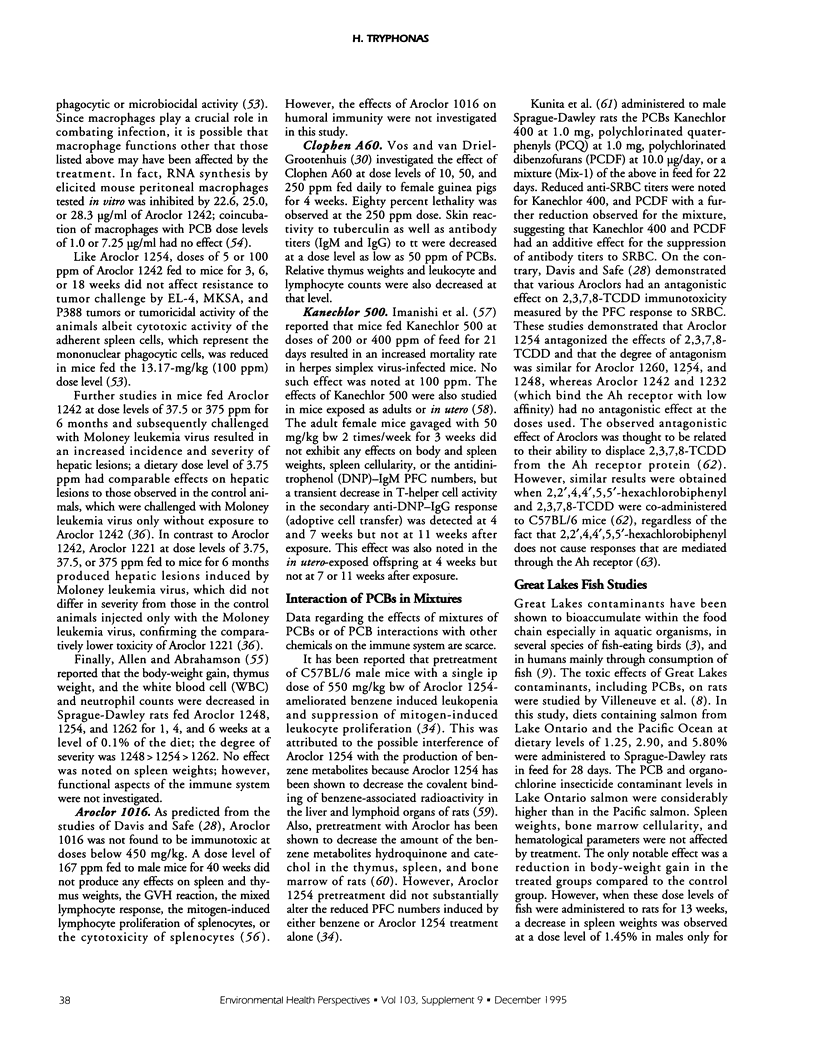
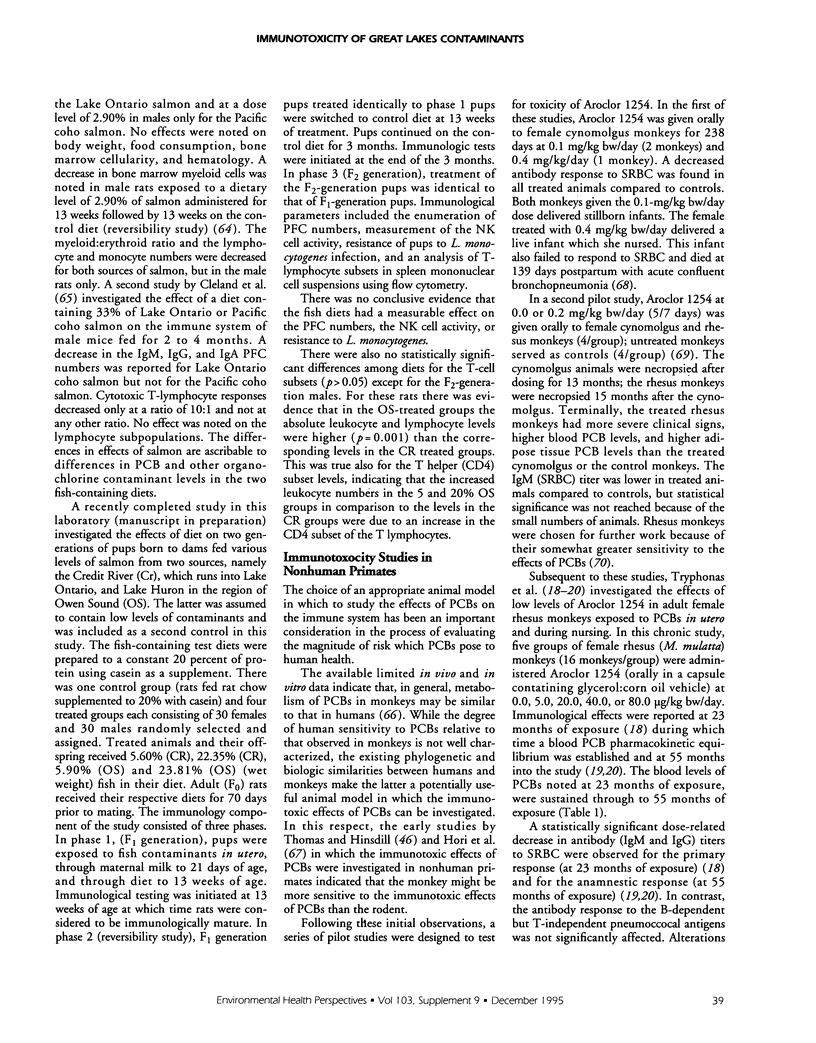
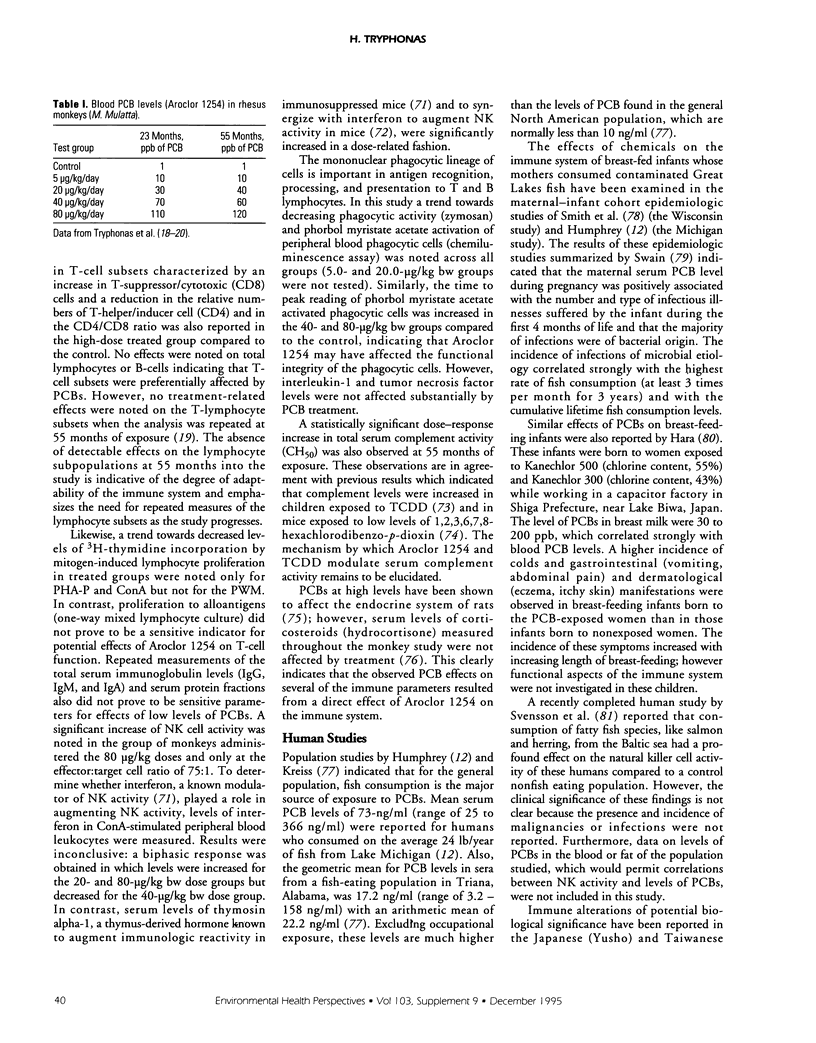
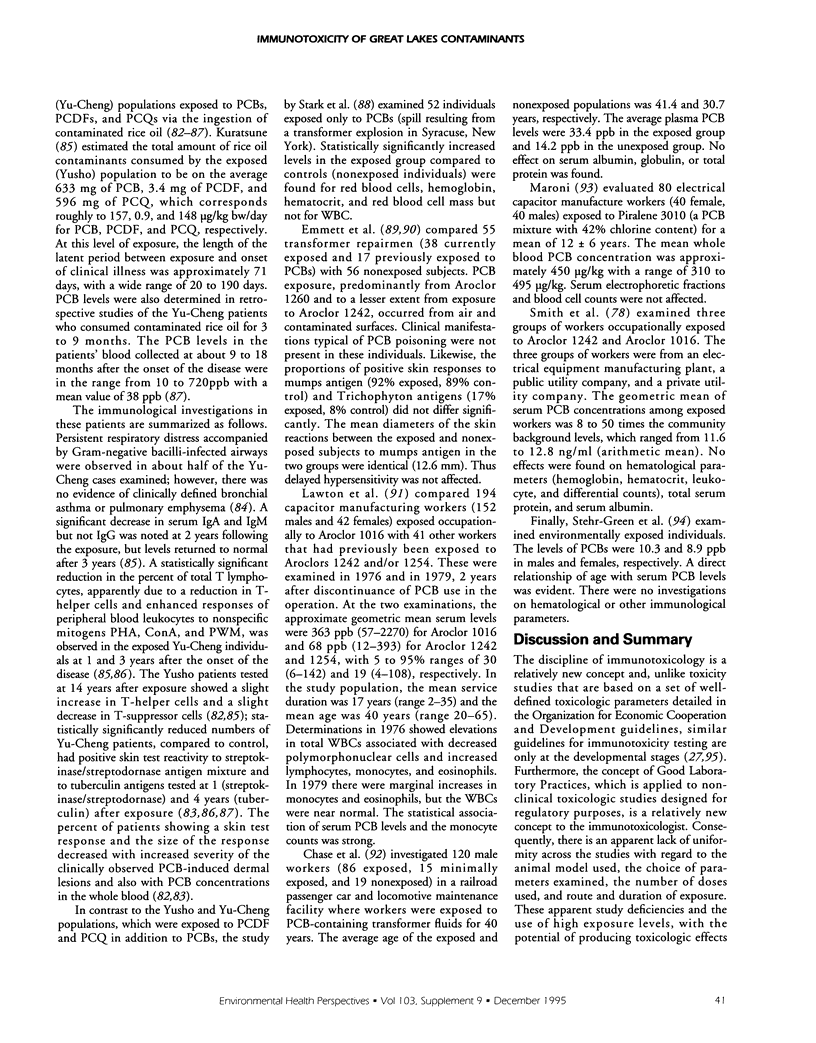
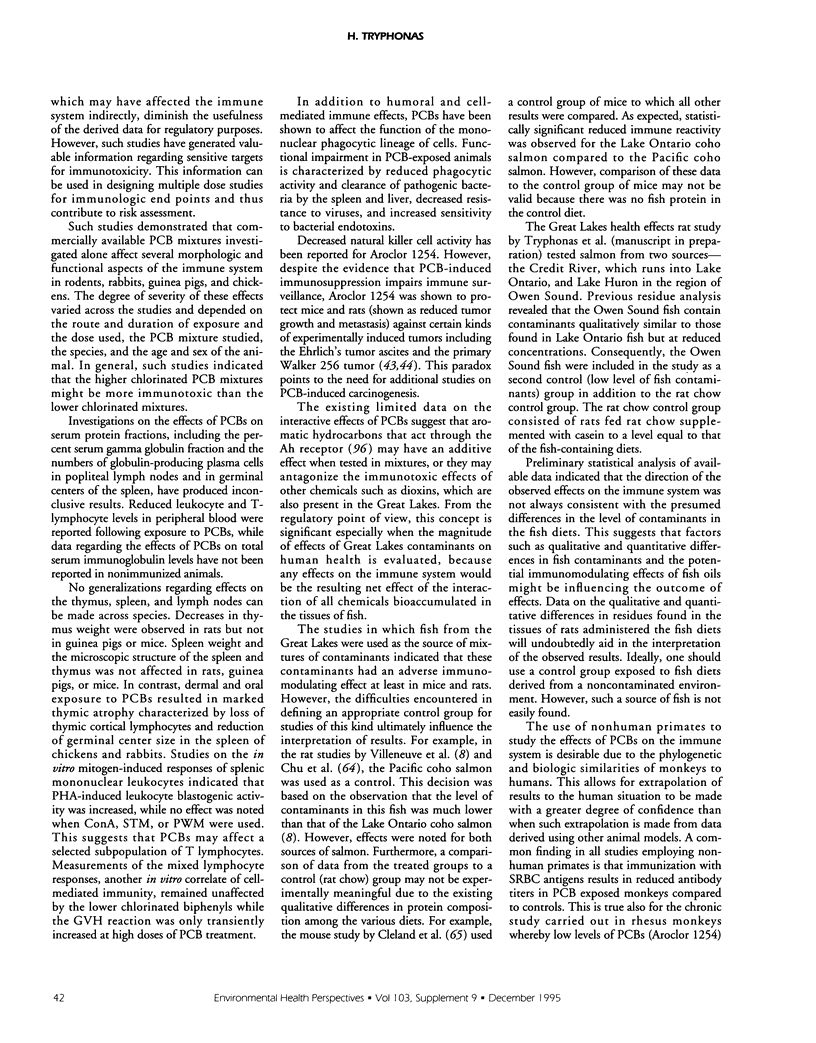
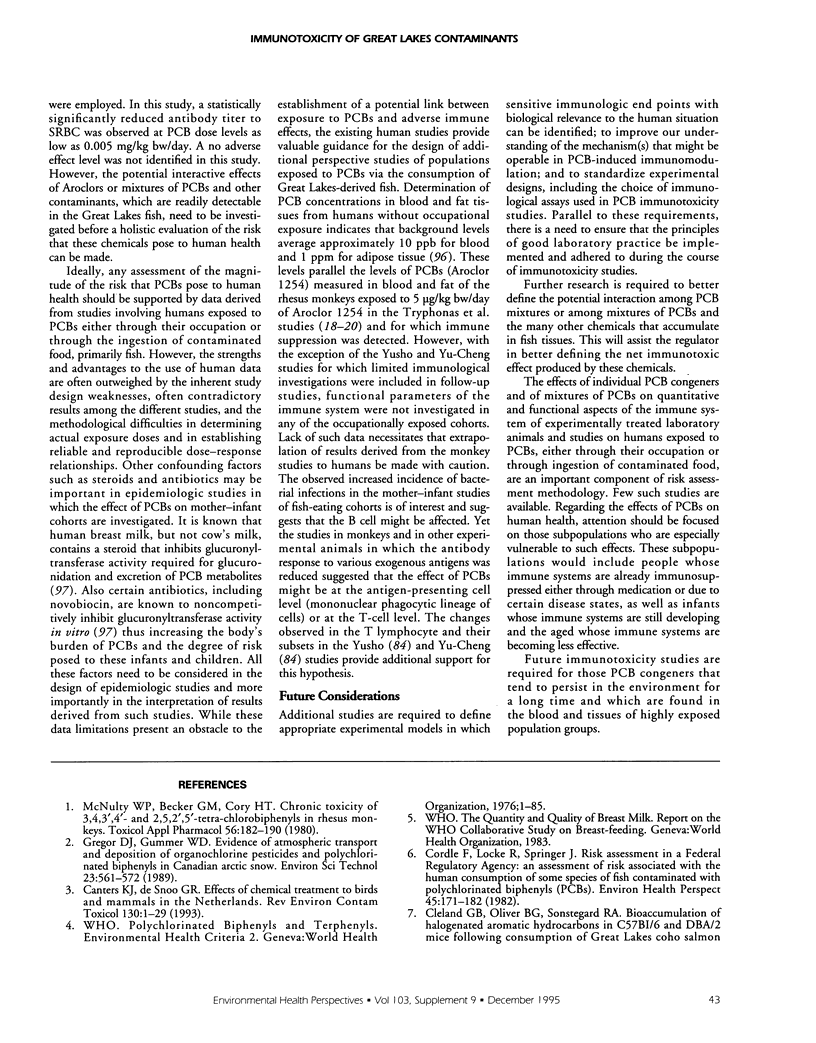
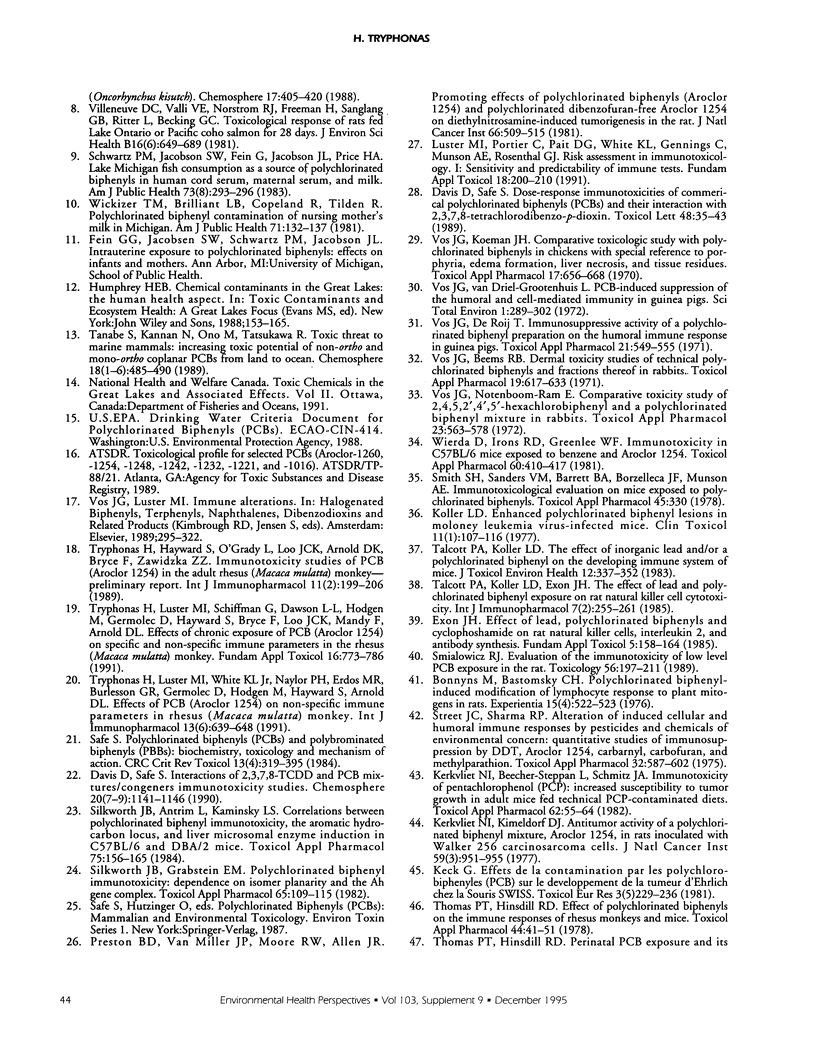
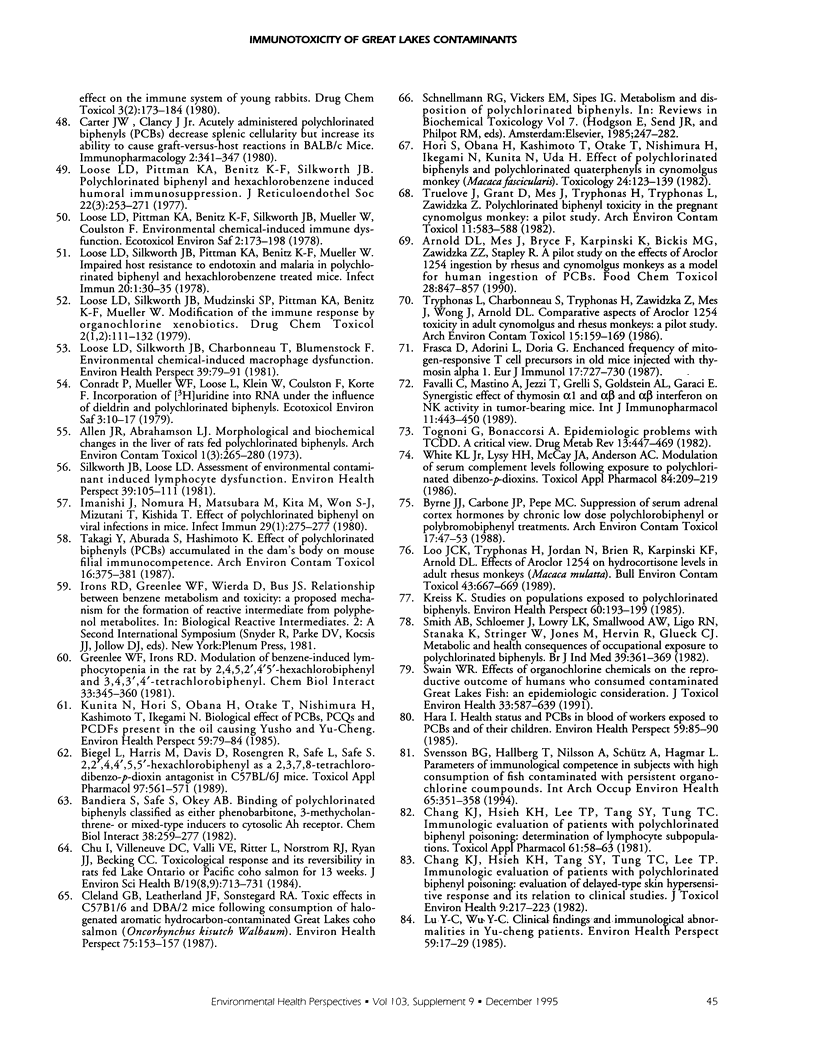
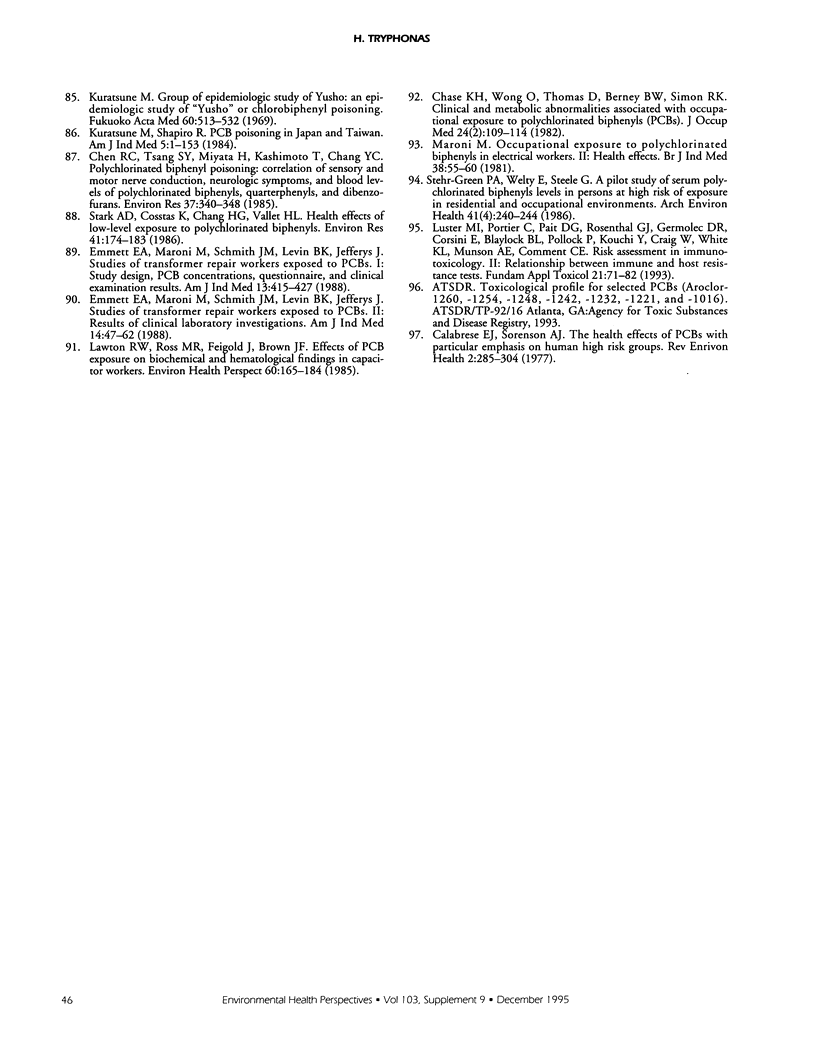
Selected References
These references are in PubMed. This may not be the complete list of references from this article.
- Allen J. R., Abrahamson L. J. Morphological and biochemical changes in the liver of rats fed polychlorinated biphenyls. Arch Environ Contam Toxicol. 1973 Oct;1(3):265–280. doi: 10.1007/BF01985749. [DOI] [PubMed] [Google Scholar]
- Arnold D. L., Mes J., Bryce F., Karpinski K., Bickis M. G., Zawidzka Z. Z., Stapley R. A pilot study on the effects of Aroclor 1254 ingestion by rhesus and cynomolgus monkeys as a model for human ingestion of PCBs. Food Chem Toxicol. 1990 Dec;28(12):847–857. doi: 10.1016/0278-6915(90)90058-u. [DOI] [PubMed] [Google Scholar]
- Bandiera S., Safe S., Okey A. B. Binding of polychlorinated biphenyls classified as either phenobarbitone-, 3-methylcholanthrene- or mixed-type inducers to cytosolic Ah receptor. Chem Biol Interact. 1982 Apr;39(3):259–277. doi: 10.1016/0009-2797(82)90045-x. [DOI] [PubMed] [Google Scholar]
- Biegel L., Harris M., Davis D., Rosengren R., Safe L., Safe S. 2,2',4,4',5,5'-hexachlorobiphenyl as a 2,3,7,8-tetrachlorodibenzo-p-dioxin antagonist in C57BL/6J mice. Toxicol Appl Pharmacol. 1989 Mar 1;97(3):561–571. doi: 10.1016/0041-008x(89)90261-5. [DOI] [PubMed] [Google Scholar]
- Bonnyns M., Bastomsky C. H. Polychlorinated biphenyl-induced modification of lymphocyte response to plant mitogens in rats. Experientia. 1976 Apr 15;32(4):522–523. doi: 10.1007/BF01920835. [DOI] [PubMed] [Google Scholar]
- Byrne J. J., Carbone J. P., Pepe M. G. Suppression of serum adrenal cortex hormones by chronic low-dose polychlorobiphenyl or polybromobiphenyl treatments. Arch Environ Contam Toxicol. 1988 Jan;17(1):47–53. doi: 10.1007/BF01055153. [DOI] [PubMed] [Google Scholar]
- Calabrese E. J., Sorenson A. J. The health effects of PCBS with particular emphasis on human high risk groups. Rev Environ Health. 1977;2(4):285–304. [PubMed] [Google Scholar]
- Canters K. J., de Snoo G. R. Chemical threat to birds and mammals in The Netherlands. Rev Environ Contam Toxicol. 1993;130:1–29. doi: 10.1007/978-1-4613-9763-2_1. [DOI] [PubMed] [Google Scholar]
- Carter J. W., Clancy J., Jr Acutely administered polychlorinated biphenyls (PCBs) decrease splenic cellularity but increase its ability to cause graft-versus-host reactions in BALB/c mice. Immunopharmacology. 1980 Dec;2(4):341–347. doi: 10.1016/0162-3109(80)90018-1. [DOI] [PubMed] [Google Scholar]
- Chang K. J., Hsieh K. H., Lee T. P., Tang S. Y., Tung T. C. Immunologic evaluation of patients with polychlorinated biphenyl poisoning: determination of lymphocyte subpopulations. Toxicol Appl Pharmacol. 1981 Oct;61(1):58–63. doi: 10.1016/0041-008x(81)90007-7. [DOI] [PubMed] [Google Scholar]
- Chang K. J., Hsieh K. H., Tang S. Y., Tung T. C., Lee T. P. Immunologic evaluation of patients with polychlorinated biphenyl poisoning: evaluation of delayed-type skin hypersensitive response and its relation to clinical studies. J Toxicol Environ Health. 1982 Feb;9(2):217–223. doi: 10.1080/15287398209530156. [DOI] [PubMed] [Google Scholar]
- Chase K. H., Wong O., Thomas D., Berney B. W., Simon R. K. Clinical and metabolic abnormalities associated with occupational exposure to polychlorinated biphenyls (PCBs). J Occup Med. 1982 Feb;24(2):109–114. [PubMed] [Google Scholar]
- Chen R. C., Tang S. Y., Miyata H., Kashimoto T., Chang Y. C., Chang K. J., Tung T. C. Polychlorinated biphenyl poisoning: correlation of sensory and motor nerve conduction, neurologic symptoms, and blood levels of polychlorinated biphenyls, quaterphenyls, and dibenzofurans. Environ Res. 1985 Aug;37(2):340–348. doi: 10.1016/0013-9351(85)90114-8. [DOI] [PubMed] [Google Scholar]
- Chu I., Villeneuve D. C., Valli V. E., Ritter L., Norstrom R. J., Ryan J. J., Becking G. C. Toxicological response and its reversibility in rats fed Lake Ontario or Pacific coho salmon for 13 weeks. J Environ Sci Health B. 1984 Nov-Dec;19(8-9):713–731. doi: 10.1080/03601238409372459. [DOI] [PubMed] [Google Scholar]
- Cleland G. B., Leatherland J. F., Sonstegard R. A. Toxic effects in C57B1/6 and DBA/2 mice following consumption of halogenated aromatic hydrocarbon-contaminated Great Lakes coho salmon (Oncorhynchus kisutch Walbaum). Environ Health Perspect. 1987 Nov;75:153–158. doi: 10.1289/ehp.8775153. [DOI] [PMC free article] [PubMed] [Google Scholar]
- Conradt P., Müller W. F., Loose L., Klein W., Coulston F., Korte F. Incorporation of [3H]uridine into RNA under the influence of dieldrin and polychlorinated biphenyls. Ecotoxicol Environ Saf. 1979 Mar;3(1):10–17. doi: 10.1016/0147-6513(79)90054-x. [DOI] [PubMed] [Google Scholar]
- Cordle F., Locke R., Springer J. Risk assessment in a federal regulatory agency: an assessment of risk associated with the human consumption of some species of fish contaminated with polychlorinated biphenyls (PCBs). Environ Health Perspect. 1982 Nov;45:171–182. doi: 10.1289/ehp.8245171. [DOI] [PMC free article] [PubMed] [Google Scholar]
- Davis D., Safe S. Dose-response immunotoxicities of commercial polychlorinated biphenyls (PCBs) and their interaction with 2,3,7,8-tetrachlorodibenzo-p-dioxin. Toxicol Lett. 1989 Jul;48(1):35–43. doi: 10.1016/0378-4274(89)90183-5. [DOI] [PubMed] [Google Scholar]
- Emmett E. A., Maroni M., Jefferys J., Schmith J., Levin B. K., Alvares A. Studies of transformer repair workers exposed to PCBs: II. Results of clinical laboratory investigations. Am J Ind Med. 1988;14(1):47–62. doi: 10.1002/ajim.4700140107. [DOI] [PubMed] [Google Scholar]
- Emmett E. A., Maroni M., Schmith J. M., Levin B. K., Jefferys J. Studies of transformer repair workers exposed to PCBs: I. Study design, PCB concentrations, questionnaire, and clinical examination results. Am J Ind Med. 1988;13(4):415–427. doi: 10.1002/ajim.4700130402. [DOI] [PubMed] [Google Scholar]
- Exon J. H., Talcott P. A., Koller L. D. Effect of lead, polychlorinated biphenyls, and cyclophosphamide on rat natural killer cells, interleukin 2, and antibody synthesis. Fundam Appl Toxicol. 1985 Feb;5(1):158–164. doi: 10.1016/0272-0590(85)90060-0. [DOI] [PubMed] [Google Scholar]
- Favalli C., Mastino A., Jezzi T., Grelli S., Goldstein A. L., Garaci E. Synergistic effect of thymosin alpha 1 and alpha beta-interferon on NK activity in tumor-bearing mice. Int J Immunopharmacol. 1989;11(5):443–450. doi: 10.1016/0192-0561(89)90172-0. [DOI] [PubMed] [Google Scholar]
- Frasca D., Adorini L., Doria G. Enhanced frequency of mitogen-responsive T cell precursors in old mice injected with thymosin alpha 1. Eur J Immunol. 1987 May;17(5):727–730. doi: 10.1002/eji.1830170524. [DOI] [PubMed] [Google Scholar]
- Greenlee W. F., Irons R. D. Modulation of benzene-induced lymphocytopenia in the rat by 2,4,5,2',4',5'-hexachlorobiphenyl and 3,4,3',4'-tetrachlorobiphenyl. Chem Biol Interact. 1981 Jan;33(2-3):345–360. doi: 10.1016/0009-2797(81)90052-1. [DOI] [PubMed] [Google Scholar]
- Hara I. Health status and PCBs in blood of workers exposed to PCBs and of their children. Environ Health Perspect. 1985 Feb;59:85–90. doi: 10.1289/ehp.59-1568101. [DOI] [PMC free article] [PubMed] [Google Scholar]
- Hori S., Obana H., Kashimoto T., Otake T., Nishimura H., Ikegami N., Kunita N., Uda H. Effect of polychlorinated biphenyls and polychlorinated quaterphenyls in Cynomolgus monkey (Macaca fascicularis). Toxicology. 1982;24(2):123–139. doi: 10.1016/0300-483x(82)90051-8. [DOI] [PubMed] [Google Scholar]
- Imanishi J., Nomura H., Matsubara M., Kita M., Won S. J., Mizutani T., Kishida T. Effect of polychlorinated biphenyl on viral infections in mice. Infect Immun. 1980 Jul;29(1):275–277. doi: 10.1128/iai.29.1.275-277.1980. [DOI] [PMC free article] [PubMed] [Google Scholar]
- Keck G. Effets de la contamination par les polychlorobiphényles (PCB) sur le développement de la tumeur d'Ehrlich chez la souris Swiss. Toxicol Eur Res. 1981 Sep;3(5):229–236. [PubMed] [Google Scholar]
- Kerkvliet N. I., Baecher-Steppan L., Schmitz J. A. Immunotoxicity of pentachlorophenol (PCP): increased susceptibility to tumor growth in adult mice fed technical PCP-contaminated diets. Toxicol Appl Pharmacol. 1982 Jan;62(1):55–64. doi: 10.1016/0041-008x(82)90101-6. [DOI] [PubMed] [Google Scholar]
- Kerkvliet N. I., Kimeldorf D. J. Antitumor activity of a polychlorinated biphenyl mixture, Aroclor 1254, in rats inoculated with Walker 256 carcinosarcoma cells. J Natl Cancer Inst. 1977 Sep;59(3):951–955. doi: 10.1093/jnci/59.3.951. [DOI] [PubMed] [Google Scholar]
- Koller L. D. Enhanced polychlorinated biphenyl lesions in Moloney leukemia virus-infected mice. Clin Toxicol. 1977;11(1):107–116. doi: 10.3109/15563657708989824. [DOI] [PubMed] [Google Scholar]
- Kreiss K. Studies on populations exposed to polychlorinated biphenyls. Environ Health Perspect. 1985 May;60:193–199. doi: 10.1289/ehp.8560193. [DOI] [PMC free article] [PubMed] [Google Scholar]
- Kunita N., Hori S., Obana H., Otake T., Nishimura H., Kashimoto T., Ikegami N. Biological effect of PCBs, PCQs and PCDFs present in the oil causing yusho and yu-cheng. Environ Health Perspect. 1985 Feb;59:79–84. doi: 10.1289/ehp.59-1568087. [DOI] [PMC free article] [PubMed] [Google Scholar]
- Lawton R. W., Ross M. R., Feingold J., Brown J. F., Jr Effects of PCB exposure on biochemical and hematological findings in capacitor workers. Environ Health Perspect. 1985 May;60:165–184. doi: 10.1289/ehp.8560165. [DOI] [PMC free article] [PubMed] [Google Scholar]
- Loo J. C., Tryphonas H., Jordan N., Brien R., Karpinski K. F., Arnold D. L. Effects of Aroclor 1254 on hydrocortisone levels in adult rhesus monkeys (Macaca mulatta). Bull Environ Contam Toxicol. 1989 Nov;43(5):667–669. doi: 10.1007/BF01701985. [DOI] [PubMed] [Google Scholar]
- Loose L. D., Pittman K. A., Benitz K. F., Silkworth J. B., Mueller W., Coulston F. Environmental chemical-induced immune dysfunction. Ecotoxicol Environ Saf. 1978 Sep;2(2):173–198. doi: 10.1016/0147-6513(78)90008-8. [DOI] [PubMed] [Google Scholar]
- Loose L. D., Pittman K. A., Benitz K. F., Silkworth J. B. Polychlorinated biphenyl and hexachlorobenzene induced humoral immunosuppression. J Reticuloendothel Soc. 1977 Sep;22(3):253–271. [PubMed] [Google Scholar]
- Loose L. D., Silkworth J. B., Charbonneau T., Blumenstock F. Environmental chemical-induced macrophage dysfunction. Environ Health Perspect. 1981 Jun;39:79–92. doi: 10.1289/ehp.813979. [DOI] [PMC free article] [PubMed] [Google Scholar]
- Loose L. D., Silkworth J. B., Mudzinski S. P., Pittman K. A., Benitz K. F., Mueller W. Modification of the immune response by organochlorine xenobiotics. Drug Chem Toxicol. 1979;2(1-2):111–132. doi: 10.3109/01480547908993185. [DOI] [PubMed] [Google Scholar]
- Loose L. D., Silkworth J. B., Pittman K. A., Benitz K. F., Mueller W. Impaired host resistance to endotoxin and malaria in polychlorinated biphenyl- and hexachlorobenzene-treated mice. Infect Immun. 1978 Apr;20(1):30–35. doi: 10.1128/iai.20.1.30-35.1978. [DOI] [PMC free article] [PubMed] [Google Scholar]
- Luster M. I., Portier C., Pait D. G., Rosenthal G. J., Germolec D. R., Corsini E., Blaylock B. L., Pollock P., Kouchi Y., Craig W. Risk assessment in immunotoxicology. II. Relationships between immune and host resistance tests. Fundam Appl Toxicol. 1993 Jul;21(1):71–82. doi: 10.1006/faat.1993.1074. [DOI] [PubMed] [Google Scholar]
- Luster M. I., Portier C., Pait D. G., White K. L., Jr, Gennings C., Munson A. E., Rosenthal G. J. Risk assessment in immunotoxicology. I. Sensitivity and predictability of immune tests. Fundam Appl Toxicol. 1992 Feb;18(2):200–210. doi: 10.1016/0272-0590(92)90047-l. [DOI] [PubMed] [Google Scholar]
- Lü Y. C., Wu Y. C. Clinical findings and immunological abnormalities in Yu-Cheng patients. Environ Health Perspect. 1985 Feb;59:17–29. doi: 10.1289/ehp.59-1568085. [DOI] [PMC free article] [PubMed] [Google Scholar]
- Maroni M., Colombi A., Arbosti G., Cantoni S., Foa V. Occupational exposure to polychlorinated biphenyls in electrical workers. II. Health effects. Br J Ind Med. 1981 Feb;38(1):55–60. doi: 10.1136/oem.38.1.55. [DOI] [PMC free article] [PubMed] [Google Scholar]
- McNulty W. P., Becker G. M., Cory H. T. Chronic toxicity of 3,4,3',4'- and 2,5,2',5'-tetrachlorobiphenyls in rhesus macaques. Toxicol Appl Pharmacol. 1980 Nov;56(2):182–190. doi: 10.1016/0041-008x(80)90288-4. [DOI] [PubMed] [Google Scholar]
- Preston B. D., Van Miller J. P., Moore R. W., Allen J. R. Promoting effects of polychlorinated biphenyls (Aroclor 1254) and polychlorinated dibenzofuran-free Aroclor 1254 on diethylnitrosamine-induced tumorigenesis in the rat. J Natl Cancer Inst. 1981 Mar;66(3):509–515. [PubMed] [Google Scholar]
- Safe S. Polychlorinated biphenyls (PCBs) and polybrominated biphenyls (PBBs): biochemistry, toxicology, and mechanism of action. Crit Rev Toxicol. 1984;13(4):319–395. doi: 10.3109/10408448409023762. [DOI] [PubMed] [Google Scholar]
- Schwartz P. M., Jacobson S. W., Fein G., Jacobson J. L., Price H. A. Lake Michigan fish consumption as a source of polychlorinated biphenyls in human cord serum, maternal serum, and milk. Am J Public Health. 1983 Mar;73(3):293–296. doi: 10.2105/ajph.73.3.293. [DOI] [PMC free article] [PubMed] [Google Scholar]
- Silkworth J. B., Antrim L., Kaminsky L. S. Correlations between polychlorinated biphenyl immunotoxicity, the aromatic hydrocarbon locus, and liver microsomal enzyme induction in C57BL/6 and DBA/2 mice. Toxicol Appl Pharmacol. 1984 Aug;75(1):156–165. doi: 10.1016/0041-008x(84)90086-3. [DOI] [PubMed] [Google Scholar]
- Silkworth J. B., Grabstein E. M. Polychlorinated biphenyl immunotoxicity: dependence on isomer planarity and the Ah gene complex. Toxicol Appl Pharmacol. 1982 Aug;65(1):109–115. doi: 10.1016/0041-008x(82)90368-4. [DOI] [PubMed] [Google Scholar]
- Silkworth J. B., Loose L. D. Assessment of environmental contaminant-induced lymphocyte dysfunction. Environ Health Perspect. 1981 Jun;39:105–128. doi: 10.1289/ehp.8139105. [DOI] [PMC free article] [PubMed] [Google Scholar]
- Smialowicz R. J., Andrews J. E., Riddle M. M., Rogers R. R., Luebke R. W., Copeland C. B. Evaluation of the immunotoxicity of low level PCB exposure in the rat. Toxicology. 1989 Jun 1;56(2):197–211. doi: 10.1016/0300-483x(89)90133-9. [DOI] [PubMed] [Google Scholar]
- Smith A. B., Schloemer J., Lowry L. K., Smallwood A. W., Ligo R. N., Tanaka S., Stringer W., Jones M., Hervin R., Glueck C. J. Metabolic and health consequences of occupational exposure to polychlorinated biphenyls. Br J Ind Med. 1982 Nov;39(4):361–369. doi: 10.1136/oem.39.4.361. [DOI] [PMC free article] [PubMed] [Google Scholar]
- Stark A. D., Costas K., Chang H. G., Vallet H. L. Health effects of low-level exposure to polychlorinated biphenyls. Environ Res. 1986 Oct;41(1):174–183. doi: 10.1016/s0013-9351(86)80179-7. [DOI] [PubMed] [Google Scholar]
- Stehr-Green P. A., Ross D., Liddle J., Welty E., Steele G. A pilot study of serum polychlorinated biphenyl levels in persons at high risk of exposure in residential and occupational environments. Arch Environ Health. 1986 Jul-Aug;41(4):240–244. doi: 10.1080/00039896.1986.9938339. [DOI] [PubMed] [Google Scholar]
- Street J. C., Sharma R. P. Alteration of induced cellular and humoral immune responses by pesticides and chemicals of environmental concern: quantitative studies of immunosuppression by DDT, aroclor 1254, carbaryl, carbofuran, and methylparathion. Toxicol Appl Pharmacol. 1975 Jun;32(3):587–602. doi: 10.1016/0041-008x(75)90123-4. [DOI] [PubMed] [Google Scholar]
- Svensson B. G., Hallberg T., Nilsson A., Schütz A., Hagmar L. Parameters of immunological competence in subjects with high consumption of fish contaminated with persistent organochlorine compounds. Int Arch Occup Environ Health. 1994;65(6):351–358. doi: 10.1007/BF00383243. [DOI] [PubMed] [Google Scholar]
- Swain W. R. Effects of organochlorine chemicals on the reproductive outcome of humans who consumed contaminated Great Lakes fish: an epidemiologic consideration. J Toxicol Environ Health. 1991 Aug;33(4):587–639. doi: 10.1080/15287399109531541. [DOI] [PubMed] [Google Scholar]
- Takagi Y., Aburada S., Otake T., Ikegami N. Effect of polychlorinated biphenyls (PCBs) accumulated in the dam's body on mouse filial immunocompetence. Arch Environ Contam Toxicol. 1987 May;16(3):375–381. doi: 10.1007/BF01054956. [DOI] [PubMed] [Google Scholar]
- Talcott P. A., Koller L. D., Exon J. H. The effect of lead and polychlorinated biphenyl exposure on rat natural killer cell cytotoxicity. Int J Immunopharmacol. 1985;7(2):255–261. doi: 10.1016/0192-0561(85)90034-7. [DOI] [PubMed] [Google Scholar]
- Talcott P. A., Koller L. D. The effect of inorganic lead and/or a polychlorinated biphenyl on the developing immune system of mice. J Toxicol Environ Health. 1983 Aug-Sep;12(2-3):337–352. doi: 10.1080/15287398309530431. [DOI] [PubMed] [Google Scholar]
- Thomas P. T., Hinsdill R. D. Effect of polychlorinated biphenyls on the immune responses of rhesus monkeys and mice. Toxicol Appl Pharmacol. 1978 Apr;44(1):41–51. doi: 10.1016/0041-008x(78)90282-x. [DOI] [PubMed] [Google Scholar]
- Thomas P. T., Hinsdill R. D. Perinatal PCB exposure and its effect on the immune system of young rabbits. Drug Chem Toxicol. 1980;3(2):173–184. doi: 10.3109/01480548009108281. [DOI] [PubMed] [Google Scholar]
- Tognoni G., Bonaccorsi A. Epidemiological problems with TCDD (a critical view). Drug Metab Rev. 1982;13(3):447–469. doi: 10.3109/03602538209029989. [DOI] [PubMed] [Google Scholar]
- Truelove J., Grant D., Mes J., Tryphonas H., Tryphonas L., Zawidzka Z. Polychlorinated biphenyl toxicity in the pregnant cynomolgus monkey: a pilot study. Arch Environ Contam Toxicol. 1982 Sep;11(5):583–588. doi: 10.1007/BF01056366. [DOI] [PubMed] [Google Scholar]
- Tryphonas H., Hayward S., O'Grady L., Loo J. C., Arnold D. L., Bryce F., Zawidzka Z. Z. Immunotoxicity studies of PCB (Aroclor 1254) in the adult rhesus (Macaca mulatta) monkey--preliminary report. Int J Immunopharmacol. 1989;11(2):199–206. doi: 10.1016/0192-0561(89)90072-6. [DOI] [PubMed] [Google Scholar]
- Tryphonas H., Luster M. I., Schiffman G., Dawson L. L., Hodgen M., Germolec D., Hayward S., Bryce F., Loo J. C., Mandy F. Effect of chronic exposure of PCB (Aroclor 1254) on specific and nonspecific immune parameters in the rhesus (Macaca mulatta) monkey. Fundam Appl Toxicol. 1991 May;16(4):773–786. doi: 10.1016/0272-0590(91)90163-x. [DOI] [PubMed] [Google Scholar]
- Tryphonas H., Luster M. I., White K. L., Jr, Naylor P. H., Erdos M. R., Burleson G. R., Germolec D., Hodgen M., Hayward S., Arnold D. L. Effects of PCB (Aroclor 1254) on non-specific immune parameters in rhesus (Macaca mulatta) monkeys. Int J Immunopharmacol. 1991;13(6):639–648. doi: 10.1016/0192-0561(91)90176-8. [DOI] [PubMed] [Google Scholar]
- Tryphonas L., Charbonneau S., Tryphonas H., Zawidzka Z., Mes J., Wong J., Arnold D. L. Comparative aspects of Aroclor 1254 toxicity in adult cynomolgus and rhesus monkeys: a pilot study. Arch Environ Contam Toxicol. 1986 Feb;15(2):159–169. doi: 10.1007/BF01059965. [DOI] [PubMed] [Google Scholar]
- Vos J. G., Beems R. B. Dermal toxicity studies of technical polychlorinated biphenyls and fractions thereof in rabbits. Toxicol Appl Pharmacol. 1971 Aug;19(4):617–633. doi: 10.1016/0041-008x(71)90294-8. [DOI] [PubMed] [Google Scholar]
- Vos J. G., Koeman J. H. Comparative toxicologic study with polychlorinated biphenyls in chickens with special reference to porphyria, edema formation, liver necrosis, and tissue residues. Toxicol Appl Pharmacol. 1970 Nov;17(3):656–668. doi: 10.1016/0041-008x(70)90040-2. [DOI] [PubMed] [Google Scholar]
- Vos J. G., Notenboom-Ram E. Comparative toxicity study of 2,4,5,2',4',5'-hexachlorobiphenyl and a polychlorinated biphenyl mixture in rabbits. Toxicol Appl Pharmacol. 1972 Dec;23(4):563–578. doi: 10.1016/0041-008x(72)90097-x. [DOI] [PubMed] [Google Scholar]
- Vos J. G., de Roij T. Immunosuppressive activity of a polychlorinated diphenyl preparation on the humoral immune response in guinea pigs. Toxicol Appl Pharmacol. 1972 Apr;21(4):549–555. doi: 10.1016/0041-008x(72)90011-7. [DOI] [PubMed] [Google Scholar]
- Vos J. G., van Driel-Grootenhuis L. PCB-induced suppression of the humoral and cell-mediated immunity in guinea pigs. Sci Total Environ. 1972 Nov;1(3):289–302. doi: 10.1016/0048-9697(72)90024-1. [DOI] [PubMed] [Google Scholar]
- White K. L., Jr, Lysy H. H., McCay J. A., Anderson A. C. Modulation of serum complement levels following exposure to polychlorinated dibenzo-p-dioxins. Toxicol Appl Pharmacol. 1986 Jun 30;84(2):209–219. doi: 10.1016/0041-008x(86)90128-6. [DOI] [PubMed] [Google Scholar]
- Wickizer T. M., Brilliant L. B., Copeland R., Tilden R. Polychlorinated biphenyl contamination of nursing mothers' milk in Michigan. Am J Public Health. 1981 Feb;71(2):132–137. doi: 10.2105/ajph.71.2.132. [DOI] [PMC free article] [PubMed] [Google Scholar]
- Wierda D., Irons R. D., Greenlee W. F. Immunotoxicity in C57BL/6 mice exposed to benzene and Aroclor 1254. Toxicol Appl Pharmacol. 1981 Sep 30;60(3):410–417. doi: 10.1016/0041-008x(81)90325-2. [DOI] [PubMed] [Google Scholar]


